Samsung Galaxy S 4 Review - Part 1
by Brian Klug on April 24, 2013 12:01 AM ESTDisplay
We wrote about how we suspected that SGS4 would go to a 5-inch 1080p SAMOLED display just after CES. Turns out that was spot on, as the SGS4 includes a 5-inch 1080p Full HD SAMOLED panel, the latest in Samsung's AMOLED roadmap. Samsung's naming stays true, and there's no Plus tacked on at the end, so we get another non-RGB stripe subpixel geometry with SGS4. The last few Samsung AMOLED variants we've seen have had different subpixel grids, and the one on the SGS4 is possibly the most interesting to date. There's still a bias toward more green subpixels than blue or red, this isn't an RGB stripe at all, but instead of the previous RG,BG layout we see this offset pattern with green on one line, then blue and red on another line. Interestingly enough the blue subpixel appears to be a square, and red and green appear to be circles, with the difference in area possibly offsetting the luminous efficiency of each material. Whatever the reason (Samsung has never been official or forthcoming any of these subpixel patterns each time they've changed them) it's present on the SGS4.
At this size however I have to admit that I find the pursuit of the subpixel geometry more of an educational one than something which affects users. While I could occasionally see it on the SGS3, I definitely do not see it on SGS4. The subpixels are now small enough that whatever the pattern, it all looks like a homogenous light-emitting surface, which was the goal after all. I could bring up the visual acuity discussion again but just trust me that it's small enough to not be visible even with actually perfect (not legally perfect, which is different) vision.
So resolution is great and up to par with all the other LCD-bearing flagships this year, lack of RGB stripe notwithstanding. There's that remaining question about brightness, contrast, outdoor visibility, and of course calibration and the saturation issue that has persisted with AMOLED from generation to generation.
On the brightness front, the SGS4 includes dynamic contrast functions that cannot be disabled and change as a function of what is being displayed. There's an "auto adjust screen tone" checkbox under display but don't let that fool you, that doesn't disable dynamic contrast, just white point. Under screen mode are the mDNIe toggles we've seen on countless other previous Samsung Android phones with AMOLED panels, only here we notice something interesting. There have always been four toggles as long as this option has existed, only what's different is now, one of them is named "Professional photo." Reviews of other regional variants of the SGS4 have included the same button but marked "Adobe RGB." Oddly enough it seems that the North American versions at least have this renamed for some reason, but undoubtedly the function is the same. Many speculated that this is now a toggle for some full CMS (Color Management System) which "fixes" the inherent color space issues with AMOLED and oversaturation that occurs when looking at sRGB content on such devices. Unfortunately, I can confirm that my initial suspicions that this is just a continuation of the mDNIe (lite) settings from previous generation is in fact correct. I reverse engineered what I could of these settings from both kernel messages while changing the toggles, and looking at the kernel sources. Turns out that 'Professional photo' mode is actually the 'Natural' mode renamed from previous versions.
So the question was whether the color space or white point actually does change with this mode enabled. I ran the SGS4 through our display tests in each of the modes and think the full color space plot tells the story. The sanest of them all really ends up being the strangely-named 'Movie' mode. Professional photo gives the big gamut with a white point closer to 'Movie,' which is to say around 7000K, but it doesn't fundamentally change the still-present oversaturation or color management issue that exists in Android with these wide gamut displays. Most users admittedly don't care however and just see "bright" colors. Theres' an Auto mode as well which the device ships with that basically has a matrix of mDNIe settings for targeted applications (for example the Gallery, Browser, Video playback) and so forth get settings, which you can see in the kernel.
| CalMAN Display Comparison | ||||||||||||
| Metric | iPhone 5 | iPhone 4S | HTC One X | SGS3 | Samsung Galaxy Note 2 | Google Nexus 4 | HTC Droid DNA | HTC One | SGS4 | |||
| Grayscale 200nits Avg dE2000 | 3.564 | 6.162 | 6.609 | 4.578 | 5.867 | 7.686 | 6.738 | 5.391 | 7.511 | |||
| CCT Avg (K) | 6925 | 7171 | 5944 | 6809 | 7109 | 8506 | 8108 | 8118 | 7020 | |||
| Saturation Sweep Avg dE2000 | 3.591 | 8.787 | 5.066 | 5.460 | 7.986 | 8.517 | 5.856 | 3.365 | 7.823 | |||
| GMB ColorChecker Avg dE2000 | 4.747 | 6.328 | 6.963 | 7.322 | 8.185 | 7.531 | 6.687 | 4.656 | 7.440 | |||
In the "Movie" mode things are better controlled than the Note 2 on the GMB color checker card test, which is the most important one for me. White point is also no longer the crazy 8000K that we saw before, 7000K is commendable for Samsung at this point. Keep in mind that maximum brightness changes in each mode as well as we effectively clamp things, I measured a maximum of 319 nits in Dynamic mode, 311 nits in Movie mode, and 255 nits in Standard, for example.
Running the display at maximum brightness for too long will also get you into an overheating or thermal protection mode as well, which we've seen on countless other AMOLED variants. Most of the time I suspect users will run on Auto brightness however which keeps brightness down to a much lower level to save battery and prevent that from becoming a problem.
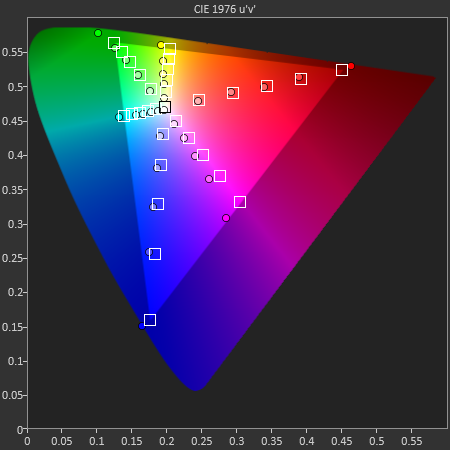
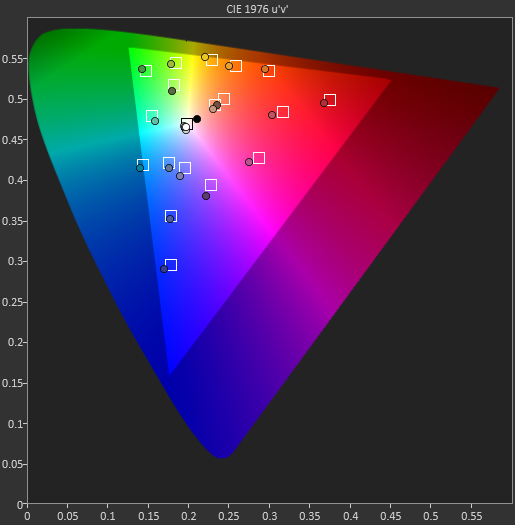
Because "Movie" was the closest to sRGB of all the modes, I selected it for the actual results that I'll present in the table. Admittedly this mode does tighten things up a bit, but it still isn't perfect and I'd still like to see Samsung do something to reign this in at some point.


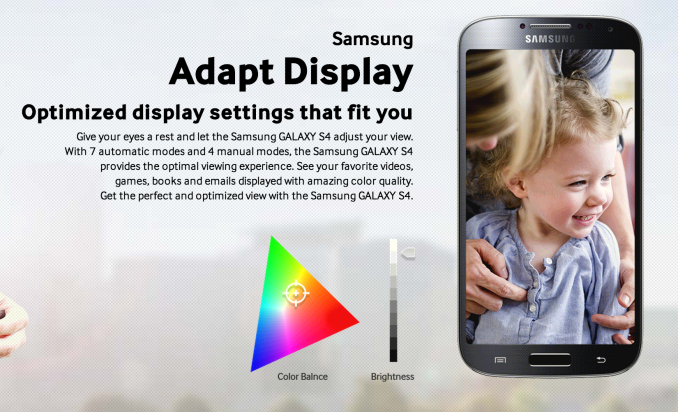




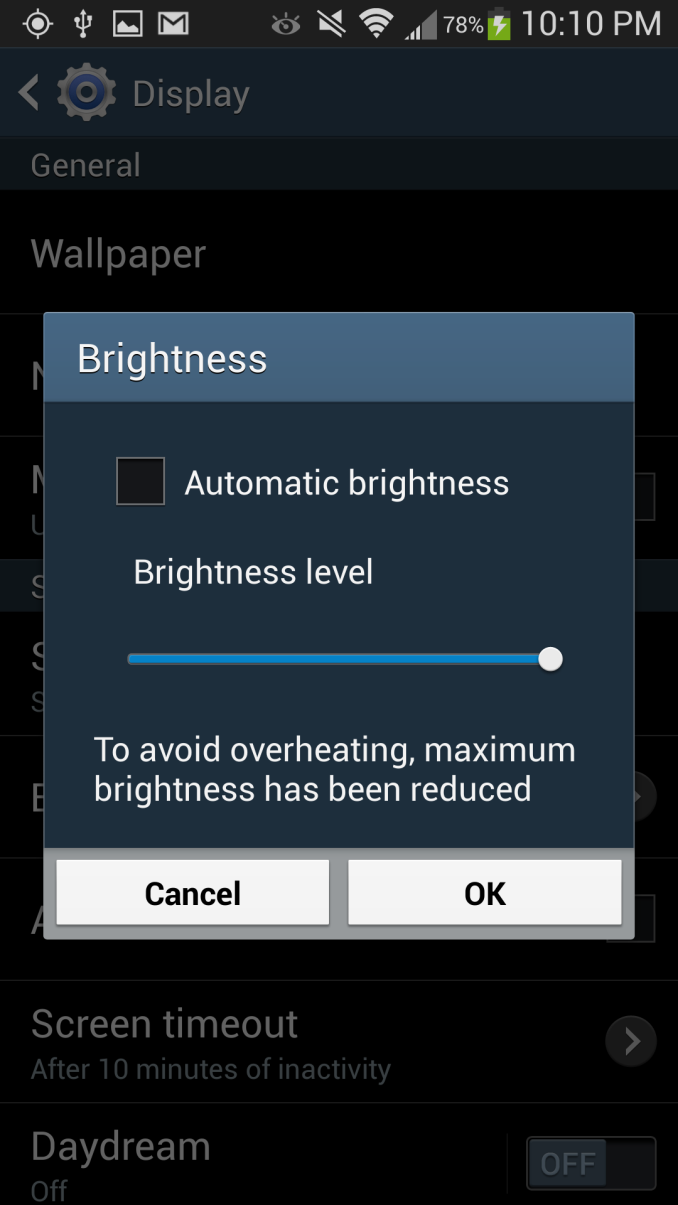
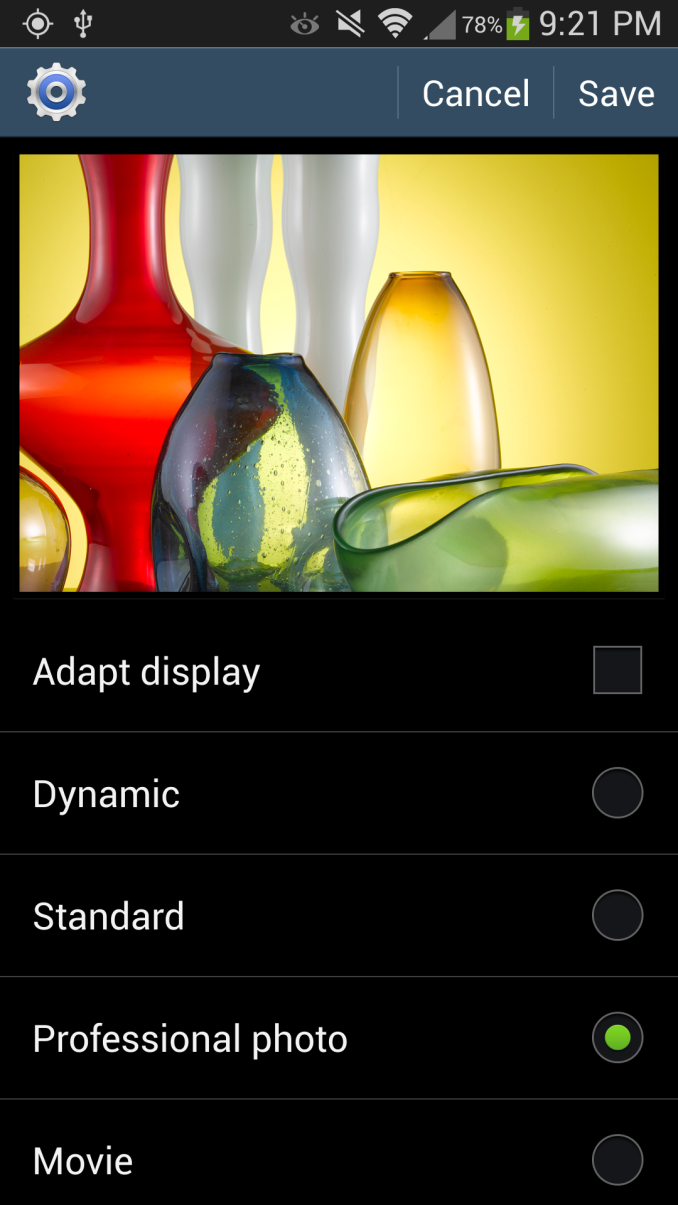
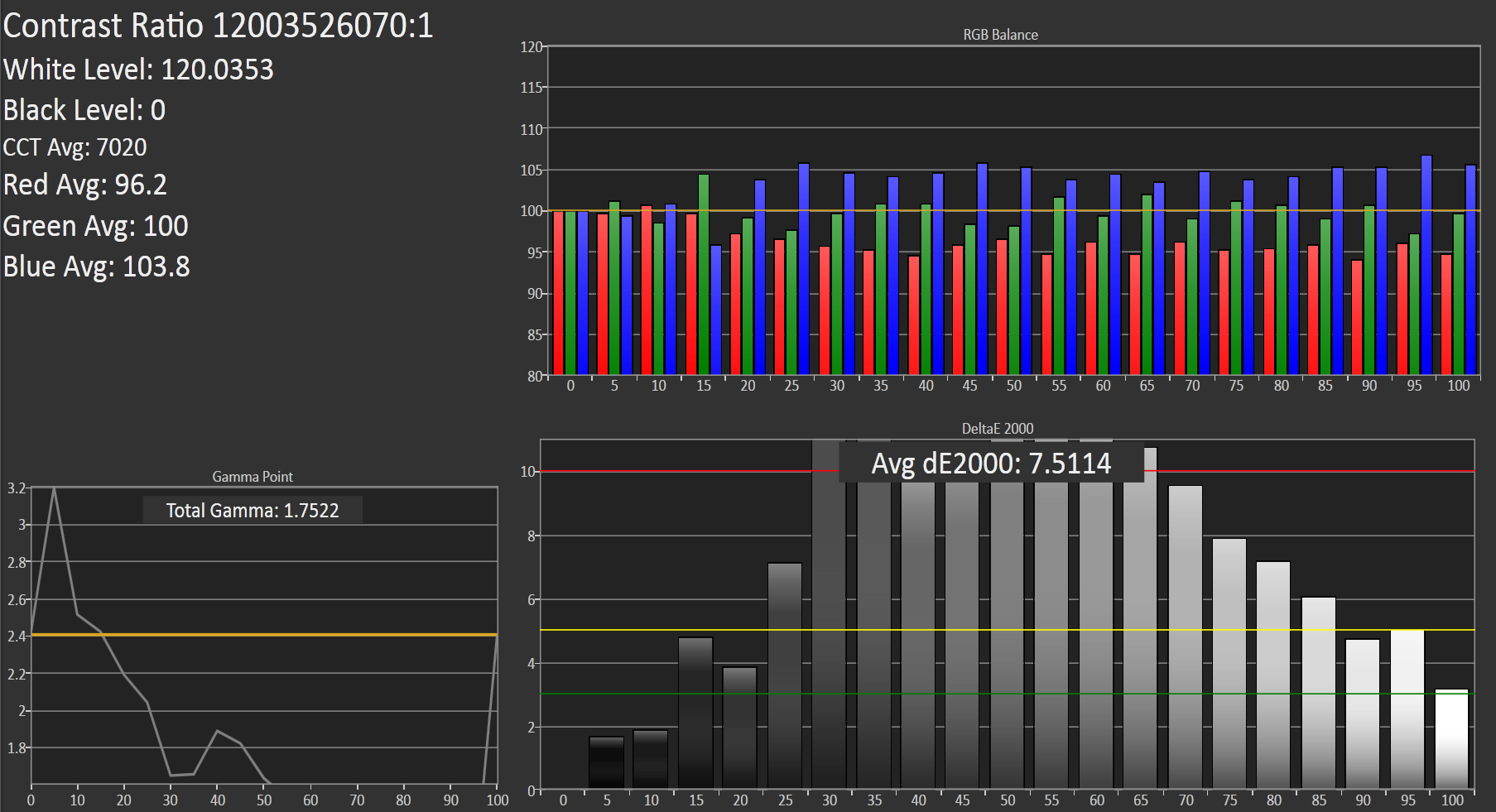








335 Comments
View All Comments
Notmyusualid - Wednesday, April 24, 2013 - link
Exactly - mine won't see a case at all.I wanted to hold out for my removable battery & SD slot, but since my SGS2 had such poor audio, (thus meaning I often missed calls in a noisy communications / server environment), I gave in, and my new HTC One will arrive tomorrow.
I might have lived with the plastic though, I had no case on my SGS2, and loved how light it was.
A 4" version of either the SGS4 or HTC One with no skimping on internals would have me jumping for joy though...
Thegonagle - Wednesday, April 24, 2013 - link
I usually put phones in a case when I'm going out (and definitely if I'm carrying my smartphone on the job instead of my flip phone), but I like using them naked at home. So design still matters.cdef - Saturday, April 27, 2013 - link
This phone really doesn't even need a case unless the owner is especially clumsy. Gorilla Glass 3 is pretty impressive. My Galaxy Nexus is unscathed after two years with it's "fortified glass" of unspecified brand. Naked phones FTW.sAiyAnstAr - Thursday, May 2, 2013 - link
I don't use cases anyway, so that point to me is not valid. I have the HTC Sensation and ONE X and have dropped them both numerous times on the face and back. The ONE X's plastic case is more worse-for-wear even though its newer than my Sensation.Diorarat - Thursday, August 1, 2013 - link
Gs4 is a cheap plastic phone. It is cheap because of the played out the design. When I shell out cash for a premium phone I want to feel that it is premium. When I hold a gs4 it feels like playing with cheaper variants that look the same. There is the galaxy note, galaxy s3, galaxy s3 mini, galaxy grand, galaxy mega, galaxy duos and a lot more. Don't get me wrong, i had a galaxy s3 and it was a beautiful phone when it came out. But Samsung abused it's popularity by making all phones look the same at the expense of the premium feel of the galaxy S line. Htc is by far the best designed phone you can get with the same price range. It packs the same punch as a galaxy s4 at the same price with better hardware. "build, sounds, and camera *depending on how you use it"blue_urban_sky - Wednesday, April 24, 2013 - link
I believe that plastic is also chosen so it can be removable.dyc4ha - Wednesday, April 24, 2013 - link
The Chinese version of the HTC One has a removable back plate with dual sim AND microsd expansiontheblueprint - Wednesday, April 24, 2013 - link
I'm living in China now and I just found the removable back one quite disturbing, it boost the thickness to 10.2mm, and I have to give up theunibody aluminum, which is the only thing that one is superior to s4. In this case I would definitely go for a s4 with Exynos 5410blue_urban_sky - Friday, April 26, 2013 - link
I'd like to see that it must be an engineering nightmare to pull that off well.Chloiber - Thursday, April 25, 2013 - link
Right, because all removable backs up until now (including all Nokia phones from the last 10 years) have been plastic.Oh wait!